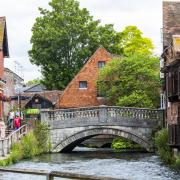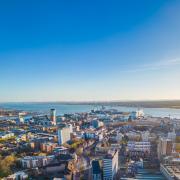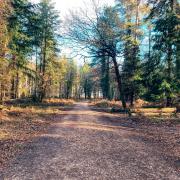This month marks 200 years since the birth of Queen Victoria and there’s one corner of Hampshire that’s celebrating more than most. We head to the Isle of Wight, Her Royal Highness’s favourite holiday destination
"It's impossible to imagine a prettier spot - valleys and woods which would be beautiful anywhere; but all this near the sea (the woods grow into the sea) is quite perfection," wrote Queen Victoria of Osborne House, her beloved seaside palace on the Isle of Wight. High praise indeed that would come to signal a golden age for this holiday hotspot.
Born at Kensington Palace, London on 24 May, 1819, Victoria first visited the island as a young 12-year-old princess with her mother. Once married to Prince Albert, the couple sought a private retreat and bought the Osborne estate, East Cowes in 1845. Although fronting on to the Solent, the Italianate-style house and formal gardens they had constructed would not look out of place beside the Bay of Naples. However, look beyond the imperial magnificence of the Durbar Room (created after Albert's death), and there can be few royal residences that so embrace family life alongside the demands of monarchy. From the intimacy of Victoria and Albert's personal bathrooms and studies, to the nursery in which each of their nine children once slept, every door unlocks another story.
So, much thought has gone into how best to mark this year's bicentenary.
"We wanted to have a 200th birthday celebration trail for adults and for children based on the presents that Victoria and Albert gave each other," says Linda Lynch, of English Heritage, adding, "It seems fitting as this was very much a family home that Albert had designed and built.
"All the objects will be easy for everyone to see and the trail will also continue outside."
With well over 100 presents to choose from, Linda hints that everything from well-known statues and paintings to ornamental trees, are likely to be included. All these mementos demonstrating the loving relationship enjoyed during their marriage.
"It will give visitors an insight into the romantic, thoughtful gifts they chose for each other, not all of which are overly extravagant," she observes.
And that's not all, as between Tuesday 28 and Thursday, 30 May the estate again hosts its annual fete, this year rebranded and expanded as the Great Victorian Show. Ticket holders are invited to welcome the royal carriage's arrival at Osborne, with arena action featuring spectacular horsemanship, amazing Victorian inventions, and thrilling fire shows. Plus, there's the chance to polish your manners at butlers' school and to learn about 19th century lotions and potions prescribed alongside the island's bracing sea air. With a specially decorated birthday parlour to set the scene, accompanied by the Queen's own words, they'll be little doubt who the guest of honour is.
This pride in Victoria's seal of approval for island life is evident everywhere. A short drive from Osborne House is St Mildred's Church in Whippingham, where the royal family worshipped and where the Queen's youngest daughter, Princess Beatrice, was married and is buried. A permanent display of memorabilia inside the church and the church centre includes a replica of the wedding dress and other gowns worn by Beatrice, as well as royal photographs.
Egypt Point, between Cowes and Gurnard, is said to have been one of Victoria's favourite places from which to watch the sunset; a panoramic view across the water that's still mesmerising today. Meanwhile, there are more natural wonders to enjoy by heading south east to Ventnor. Here, within the town's famous botanic gardens grow Trachycarpus fortunei, or Chinese windmill palms, the oldest found in the British Isles. Collected during the 19th century and presented to Victoria, she requested they be replanted inside the grounds of what then was a chest hospital. Sitting beneath the swaying fronds it's a wonderful sanctuary to escape to and well worth the diversion from the coastal path.
Afternoon tea at The Royal Hotel is another throwback to its royal patronage. Now celebrated in the colonial-style conservatory, petit gateaux, sandwiches and scones are served-up daily. Reputedly drawn to Shanklin Chine and Blackgang Chine, from a young age Victoria was a regular visitor to this corner of the island; in 1853 she was one of the first to see the skeleton of a whale washed-up near The Needles, when it was shown to an awe-struck audience.
To shed more light on where Queen Victoria and the other royals journeyed, according to Sue Emmerson at Visit Isle of Wight: "A series of Victorian themed walks will also be a feature of this year's Isle of Wight Festival of Walking." The two-week exploration of the island starting on Saturday, 4 May is certainly well worth making tracks for.
It's also possible to follow in Victoria's footsteps at Northwood House, where she and her family reputedly danced the night away at high society balls. As well as providing a fabulous wedding venue, the island community will come together at next month's annual Cowes Big Lunch with families and friends descending on Northwood's lawns to enjoy a giant picnic.
And just as Victoria and Albert embraced the Freshwater circle of writers, artists and intellectuals, Farringford, the home of Poet Laureate Alfred Lord Tennyson (a regular houseguest at Osborne) is now also open to the public.
Recalling the famous movers and shakers who visited East Cowes during this era, drawn by the royals in residence, the ribbon will be cut on yet another new trail on Friday 24 May. This one stretches from the town centre to Osborne House and features 22 engraved stones crafted by Wight Stonemasonry. The trail's opening kicks-off a weekend of events, which as local councillor Karl Love says will, "celebrate all that's good about our town and its history," topped-off by a grand procession and a Victorian Day of merriment.
It may only cover an area of 380 square kilometres, but small wonder that holidaymakers still flock to 'Victoria's Island'. This is after all, as others before them discovered, a place where lasting memories are made.
Viv travelled to the Isle of Wight on Wightlink Ferries, from Portsmouth to Fishbourne, as a guest of Visit Isle of Wight which publishes Victoria's Island Heritage Trail.
Queen Victoria's Hampshire
- Winchester: Sir Alfred Gilbert's 4.3 metre high bronze statue of Queen Victoria commemorated her Golden Jubilee, gracing the Great Hall.
- Portsmouth: Another statue, this one cast by Alfred Drury has overlooked Guildhall Square since 1897. Whilst the Historic Dockyard proudly displays HMS Warrior, the famous iron-clad warship and most powerful vessel in Victoria's fleet.
- Netley: The Royal Victoria Country Park, once the grounds of Netley Hospital, recalls Queen Victoria's insistence that injured soldiers returning from the Crimean Wars be cared for.
- Gosport: Remnants of the royal railway branch line, which transported the family to their embarkation point for the Isle of Wight, are still glimpsed at Royal Clarence Yard.
- Solent Forts: These wave-buffeted Victorian monoliths include No Man's Fort and Spitbank Fort now luxury dining and accommodation venues. More so-called Palmerston follies are found at Portsea Island, Gosport, and Portsdown Hill.
- Aldershot: Hard to imagine now, a modest wooden bungalow was once a royal pavilion for when Victoria inspected the garrison. Dismantled in the 1960s, its listed guardroom remains.
More…
- 10 of the best pubs to visit in Hampshire - Hampshire is blessed with some fantastic pubs serving up delightful, locally sourced food and drink. We round up some of the best



























